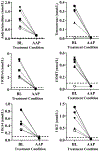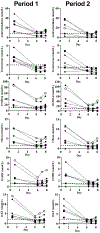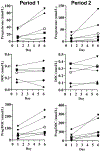Abiraterone acetate treatment lowers 11-oxygenated androgens
- PMID: 32045360
- PMCID: PMC7096060
- DOI: 10.1530/EJE-19-0905
Abiraterone acetate treatment lowers 11-oxygenated androgens
Abstract
Context: The human adrenal is the dominant source of androgens in castration-resistant prostate cancer (CRPC) and classic 21-hydroxylase deficiency (21OHD). Abiraterone, derived from the prodrug abiraterone acetate (AA), inhibits the activity of cytochrome P450 17-hydroxylase/17,20-lyase (CYP17A1), the enzyme required for all androgen biosynthesis. AA treatment effectively lowers testosterone and androstenedione in 21OHD and CRPC patients. The 11-oxygenated androgens are major adrenal-derived androgens, yet little is known regarding the effects of AA administration on 11-oxygenated androgens.
Objective: To test the hypothesis that AA therapy decreases 11-oxygenated androgens.
Design: Samples were obtained from 21OHD or CRPC participants in AA or AA plus prednisone (AAP)-treatment studies, respectively.
Methods: We employed liquid chromatography-tandem mass spectrometry (LC-MS/MS) to measure the 11-oxygenated androgens, 11β-hydroxyandrostenedione, 11-ketoandrostenedione, 11β-hydroxytestosterone, and 11-ketotestosterone, in plasma or serum samples from six 21OHD and six CRPC patients before and after treatment with AA or AAP, respectively.
Results: In CRPC patients, administration of AAP (1000 mg/day AA with prednisone and medical castration) lowered all four 11-oxygenated androgens to below the lower limits of quantitation (<0.1-0.3 nmol/L), equivalent to 64-94% reductions from baseline. In 21OHD patients, administration of AA (100-250 mg/day for 6 days) reduced all 11-oxygenated androgens by on average 56-77% from baseline.
Conclusions: We conclude that AA and AAP therapies markedly reduce the production of the adrenal-derived 11-oxygenated androgens, both in patients with high (21OHD) or normal (CRPC) 11-oxygenated androgens at baseline, respectively. Reduction of 11-oxygenated androgens is an important aspect of AA and AAP pharmacology.
Conflict of interest statement
Declaration of interest: RJA is a consultant for Janssen Pharmaceuticals.
Figures





Similar articles
-
Abiraterone acetate to lower androgens in women with classic 21-hydroxylase deficiency.J Clin Endocrinol Metab. 2014 Aug;99(8):2763-70. doi: 10.1210/jc.2014-1258. Epub 2014 Apr 29. J Clin Endocrinol Metab. 2014. PMID: 24780050 Free PMC article. Clinical Trial.
-
Adrenal-derived 11-oxygenated 19-carbon steroids are the dominant androgens in classic 21-hydroxylase deficiency.Eur J Endocrinol. 2016 May;174(5):601-9. doi: 10.1530/EJE-15-1181. Epub 2016 Feb 10. Eur J Endocrinol. 2016. PMID: 26865584 Free PMC article.
-
Androgen dynamics and serum PSA in patients treated with abiraterone acetate.Prostate Cancer Prostatic Dis. 2014 Jun;17(2):192-8. doi: 10.1038/pcan.2014.8. Epub 2014 Mar 18. Prostate Cancer Prostatic Dis. 2014. PMID: 24637537 Free PMC article. Clinical Trial.
-
Back where it belongs: 11β-hydroxyandrostenedione compels the re-assessment of C11-oxy androgens in steroidogenesis.Mol Cell Endocrinol. 2021 Apr 5;525:111189. doi: 10.1016/j.mce.2021.111189. Epub 2021 Feb 2. Mol Cell Endocrinol. 2021. PMID: 33539964 Review.
-
The clinical and biochemical significance of 11-oxygenated androgens in human health and disease.Eur J Endocrinol. 2023 Apr 5;188(4):R98-R109. doi: 10.1093/ejendo/lvad047. Eur J Endocrinol. 2023. PMID: 37041725 Review.
Cited by
-
11-Ketotestosterone is the predominant active androgen in prostate cancer patients after castration.JCI Insight. 2021 Jun 8;6(11):e148507. doi: 10.1172/jci.insight.148507. JCI Insight. 2021. PMID: 33974560 Free PMC article.
-
Salivary microbiome differences in prepubertal children with and without adrenal androgen excess.Pediatr Res. 2022 Jun;91(7):1797-1803. doi: 10.1038/s41390-021-01661-w. Epub 2021 Aug 2. Pediatr Res. 2022. PMID: 34341500 Free PMC article.
-
Testosterone histories from tusks reveal woolly mammoth musth episodes.Nature. 2023 May;617(7961):533-539. doi: 10.1038/s41586-023-06020-9. Epub 2023 May 3. Nature. 2023. PMID: 37138076
-
Reconstitution of human adrenocortical specification and steroidogenesis using induced pluripotent stem cells.Dev Cell. 2022 Nov 21;57(22):2566-2583.e8. doi: 10.1016/j.devcel.2022.10.010. Dev Cell. 2022. PMID: 36413950 Free PMC article.
-
Monitoring treatment in pediatric patients with 21-hydroxylase deficiency.Front Endocrinol (Lausanne). 2023 Feb 3;14:1102741. doi: 10.3389/fendo.2023.1102741. eCollection 2023. Front Endocrinol (Lausanne). 2023. PMID: 36843618 Free PMC article. Review.
References
-
- Auchus RJ, Lee TC, & Miller WL. Cytochrome b5 augments the 17,20 lyase activity of human P450c17 without direct electron transfer J Biol Chem 1998. 273 3158–3165. - PubMed
-
- Auchus RJ, & Rainey WE. Adrenarche - physiology, biochemistry and human disease Clin Endocrinol (Oxf) 2004. 60 288–296. - PubMed
-
- Auchus RJ. The classic and nonclassic concenital adrenal hyperplasias Endocr Pract 2015. 21 383–389. - PubMed
MeSH terms
Substances
Supplementary concepts
Grants and funding
LinkOut - more resources
Full Text Sources
Other Literature Sources
Medical
Miscellaneous

